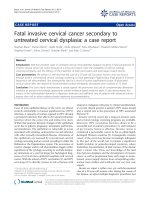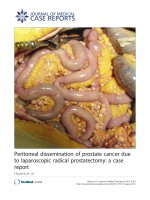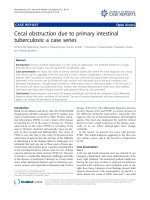Dystocia due to fetal arthrogryposis in a non-descript sheep – A case report
Bạn đang xem bản rút gọn của tài liệu. Xem và tải ngay bản đầy đủ của tài liệu tại đây (294.41 KB, 3 trang )
Int.J.Curr.Microbiol.App.Sci (2020) 9(5): 2029-2031
International Journal of Current Microbiology and Applied Sciences
ISSN: 2319-7706 Volume 9 Number 5 (2020)
Journal homepage:
Case Study
/>
Dystocia Due to Fetal Arthrogryposis in a
Non-Descript Sheep – A Case Report
C. T. Nikhade1*, S. G. Deshmukh and R. P. Kolhe
Department of Animal Reproduction Gynaecology and Obstetrics,
Post Graduate Institute of Veterinary and Animal Sciences, Akola (MS), India
*Corresponding author
ABSTRACT
Keywords
In utero, Newborn
animals, Congenital
neurologic disorders
Article Info
Accepted:
15 April 2020
Available Online:
10 May 2020
A successful case of Dystocia due to fetal Arthrogroposis in non discript
Sheep of a three year old multiparous nondescript sheep was presented with
the history of full term gestation and water bag had ruptured one hour
before with no further progress but the animal was straining. On vaginal
examination, vaginal mucus membrane was pale, cervix was fully dilated
and the fetal limbs were in birth canal. The presentation of fetus was
posterior longitudinal, position was dorsosacral with flexed knee joint of
right limb. Antibiotic and anti-inflammatory was continued for successive
five days. The dam made uneventfull recovery.
Introduction
Arthrogryposis coupled with other skeletal
deformities could be due to genetic and non
genetic environmental factor. All types of
arthrogryposis are associated with decreased
fetal movement, which can usually be
recognized by lack of normal movement in
utero using real-time ultrasound studies.
(Arthrogryposis in Calves Judith G. Hall,
Angela Vincent, Chapter 7) Congenital and
inherited abnormalities can result in birth
deformities of newborn animals. Congenital
disorders can be due to viral infections of the
foetus or to ingestion of toxic plants by the
dam at certain stages of gestation. The
musculoskeletal system can also be affected
by certain congenital neurologic disorders
(Central Highland Veterinary Group).
Arthrogryposis (joints fixed in abnormal
positions) is one such birth defect seen in
cattle and sheep. Causes include infections of
the dam with Akabane virus and Pestivirus
(Mucosal disease in cattle and Border disease
in sheep), as well as inherited defects.
Arthrogryposis refers to the fixed flexion of
one or more joints and wasting of muscles.
2029
Int.J.Curr.Microbiol.App.Sci (2020) 9(5): 2029-2031
Severely affected calves are usually born dead
and often cause calving difficulties (dystocia),
necessitating an embryotomy to deliver them.
Arthrogryposis usually occurs at an early
stage in an outbreak.
Arthrogryposis occurs mainly due to an
alkaloid toxin that acts on the musculoskeletal
system leading to permanent joint contracture
in forelimbs and/or hind limbs (Shupe et al.,
1967a). The affected limbs cannot be
straightening out (Hartley et al., 1974;
Sprake, 2015) and may include incorrect
articular
arrangement
or
rotational
irregularity.
Case history and observation
A three year old multiparous nondescript
sheep was presented with the history of full
term gestation and water bag had ruptured one
hour before with no further progress but the
animal was straining (Fig. 1) and was trying
to expel the fetus. She was dull and depressed
with the temperature of 103 °F. On vaginal
examination, vaginal mucus membrane was
pale, cervix was fully dilated and the fetal
limbs were in birth canal. The presentation of
fetus was posterior longitudinal, position was
dorsosacral with flexed knee joint of right
limb (Fig. 2).
Treatment and discussion
The treatment was started with (25%
Dextrose and normal saline 300 ml).
Intravenous fluids and antihistamines
(cadistin 2ml) intramuscularly. Afterwards
with proper lubrication of vaginal passage the
flexed right knee was corrected and pulled out
with slight manual traction (Fig. 3). Further
examination revealed absence of other fetus.
The dam was given antibiotic (inj.
Enrofloxacin 2.5 – 5ml), analgesic (inj.
Flunixin @1.1ml) intramuscularly and two
intrauterine bolous (bolous Furea) were
introduced. Antibiotic and anti-inflammatory
was continued for successive five days. The
dam made uneventfull recovery.
Fig.1 Goat trying to expel fetus
Fig.2 After applying slight manual traction
2030
Int.J.Curr.Microbiol.App.Sci (2020) 9(5): 2029-2031
Fig.3 Fetal Arthrogryposis in Nondiscript Sheep
Arthrogryposis might be due to simple
recessive gene which results in explusion of
dead fetus with flexed limbs and wry neck in
sheep and goat. (Robert, 1971)
References
Arthrogryposis in Calves Judith G. Hall,
Angela Vincent, Chapter 7
Hartley, W. J. and Wanner, R. A. 1974.
Bovine congenital arthrogryposis in
New
South
Wales.
Australian
Veterinary Journal, 50(5): 185–188
Roberts, S.J. (1971) Veterinary Obstetrics and
Genital
Diseases,
2ndedn.CBS
Publishers and Distributers. India. Pp
59
Shupe, J. L., Binns, W., James, L. F. and
Keeler, R. F. 1967a. Lupine, a cause of
crooked calf disease. Journal of the
American
Veterinary
Medical
Association, 151(2): 198–203.
Sprake, P. 2015. Diseases of the bones, joints
and connective tissues. In: Smith, B.P.
(ed), Large Animal Internal Medicine.
St. Louis: Elsevier Mosby, pp. 1106
How to cite this article:
Nikhade, C. T., S. G. Deshmukh and Kolhe, R. P. 2020. Dystocia Due to Fetal Arthrogryposis
in a Non-Descript Sheep – A Case Report. Int.J.Curr.Microbiol.App.Sci. 9(05): 2029-2031.
doi: />
2031









